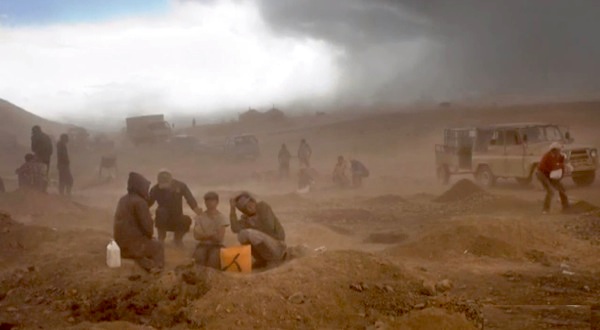India central bank hints easing of gold imports close |
- India central bank hints easing of gold imports close
- Gold price drifts lower ahead of jobs data
- Mongolia’s mining boom takes toll in locals health
- Ebola outbreak in Guinea forces miners to lock down operations
- Scientists warn silver particles harmful for humans, wildlife
- Canada must open mining to First Nations to remain competitive— study
| India central bank hints easing of gold imports close Posted: 03 Apr 2014 04:56 PM PDT Long the top importer of gold, India fell behind China in 2013. The decline in gold consumption in India came after bullion import duties were pushed up tenfold – from 1% at the start of 2012 to 10% – and other rules such as strictly cash only for imports, mandatory re-export of 20% of imports and transaction taxes stymied India's gold industry. The shortage of physical gold meant premiums over the London fix demanded by Indian gold traders from jewelers shot up as high as $180 an ounce during peak festival and wedding season last year and remain high today at $60 an ounce. That's up from $20 an ounce in the middle of March and indicates that demand is creeping back up, argues ANZ in a new research note. Lifting the restrictions could unleash the pent up demand in India which during good years take in more than a 1,000 tonnes of world supply. India is gearing up for a general election and a number of politicians have promised to lift the restrictions on the metal so central to the Indian culture. In March authorities took modest steps by allowing five private banks to import gold and earlier this week the country's finance minister commented that further lifting of restrictions are on the cards in consultation with the Reserve Bank of India. Indian Express quotes RBI Governor Raghuram Rajan on Wednesday as saying he favoured the gradual easing of curbs on gold imports: "I think what we have to do is slowly and steadily take actions to remove some of these curbs (on gold imports)," Rajan told analysts at the post-policy call with researchers and analysts today. He, however, said the timing on relaxation on gold imports needs to be discussed with the government. "It would be useful for some of the big uncertainties facing us to be behind us rather than still in front of us before major actions are taken up in this regard, but I don't rule it out," he said. In contrast to India traders on the Shanghai Gold Exchange are offering gold at a discount to the quoted London spot price. Driven in part by a weakening renminbi discounts on gold in China widened to as much as $9 an ounce below when the price were headed towards $1,400 in March. That gap has now shrunk to $2–$3 an ounce as the lower gold prices drives fresh demand and could strengthen further if the yuan begins to appreciate again as expected. |
| Gold price drifts lower ahead of jobs data Posted: 03 Apr 2014 04:12 PM PDT The price of gold returned to a declining trend on Thursday ahead of crucial US jobs data which would dictate the direction of US monetary policy. On the Comex division of the New York Mercantile Exchange, gold futures for June delivery in late trade exchanged hands for $1,286.80 an ounce, down $4.00 from Wednesday's close. As an indication of the uncertainty, volume was particularly thin with less than 100,000 contracts traded, compared average daily volumes on the exchange of around 160,000. Three disappointing jobs reports in a row – the Fed's key measure in deciding interest rates – have strengthened the hands of supporters of the Fed's economic stimulus program. But Friday's report for the month of March could show that the weakness was only a temporary setback caused by the weather. Economists polled by MarketWatch expect the Labor Department on Friday to report a 200,000 gain in new jobs last month, although some put the number much higher. Any big surprise to the upside would be bad for gold and may prompt a rethink from US Federal Reserve chair Janet Yellen who on Monday again made very dovish comments at a Chicago about the bank's quantitative easing program: "This extraordinary commitment is still needed and will be for some time, and I believe that view is widely shared by my fellow policy makers." Monetary expansion, particularly since the financial crisis, has been a massive boon for the gold price. Gold was trading around $830 an ounce when previous chairman Ben Bernanke announced QE1 in November 2008. The QE program together with other stimulus measures saw the balance sheet of the Fed cross the $4 trillion mark in January, up 400% in seven years. Gold and the US dollar usually moves in the opposite directions and gold's perceived status as a hedge against inflation is also burnished when central banks flood markets with money. The price of gold slid close to 28% in 2013 – the worst annual performance since 1980 – in anticipation of an end to the ultra-loose monetary policy, but has enjoyed 7% gains in 2014. Gold is off more than $90 an ounce from its 2014 high struck in mid-March, but Chinese buyers appear to have returned to the market and hopes for an easing of imports of bullion into number two consumer India are rising. |
| Mongolia’s mining boom takes toll in locals health Posted: 03 Apr 2014 10:24 AM PDT  In the semi-arid areas of the South Gobi desert, the extreme amount of dirt generated from poorly planned roads built for mining operations is compromising the health of local people, as well as their animals. In recent years Mongolia has gained a worldwide reputation of being "the next big thing" in mining, but the investment rush is reaching a familiar turning point, with experts warning that unchecked economic growth and mining-related infrastructure projects have begun posing a risk to the country's rich environment and biodiversity. Alongside international miners that have rushed in to tap Mongolia's vast coal, copper and gold deposits, Ibtimes.com reports there is an increasing number of illegal miners trying to get a piece of the nation's riches, especially coal, at high safety and ecological costs. "[These] miners crawl in the darkness for hundreds of metres through narrow, rambling passages before reaching the working face, where the new coal is cut. Dug with shovels and picks, the tunnels have few timber supports — a minimum safety standard in any coal mine," the article describes. But it is not only coal dust and poor safety standards what is killing miners in Mongolia. In the semi-arid areas of the South Gobi desert, the extreme amount of dirt generated from poorly planned roads built for mining operations is compromising the health of local people, as well as their animals. According to the University of Queenland's Centre for Social Responsibility in Mining the creation of these roads, which cart truckloads of minerals to neighbouring China and run through areas where many animals graze, is also leading to high degradation of pasturelands. Mining giants have given a major boost to Mongolia's economy. The country's gross domestic product is expected to spike over 15% this year, the highest growth rate in the world. In 2012, minerals comprised 30% of the nation's GDP and more than 80% of its exports, according to the Mongolia Research Hub of the Centre for Social Responsibility in Mining. Last November the government signed a deal with the country's gold producers association, which aims to reduce illegal extraction of the metal by reducing barriers for them to become formal miners. Currently an estimated 100,000 Mongolians mine informally for gold, producing more than the formal industrial sector, which alone contributes more than 20% of Mongolia's GDP. Image by NPR, via YouTube |
| Ebola outbreak in Guinea forces miners to lock down operations Posted: 03 Apr 2014 08:03 AM PDT  Image © Agus Morales/MSF Global mining companies, including Brazilian iron ore giant Vale (NYSE:VALE), are locking down operations in Guinea and evacuating some international staff as the death toll from suspected cases of the deadly Ebola virus there has already hit 84. According to data from the UN's World Health Organization (WHO), five new suspected infections were reported Monday, which has brought the total to 134 in less than two months. Medical charity Medecins Sans Frontieres (MSF) warned earlier this week the epidemic was spreading out to neighbouring West African countries, with suspected cases of one of the world's most lethal infectious diseases reported in neighbouring Liberia and Sierra Leone, and other two from Guinea quarantined in Gambia. The outbreak of the deadly virus has been concentrated around the country's southeast, adjacent to Guinea's lucrative iron ore reserves, forcing mining companies to take precautionary action. "Everyone is practicing precautionary strict hygiene but there has been no real impact on production so far," a senior executive at a mining company told Reuters. Vale has already removed its six international employees and put its local workers on leave. The Ebola virus spreads by contact, and victims present symptoms such as diarrhea, vomiting and external bleeding. No cure or vaccine has yet been found for the disease. The West African nation is also the world's top exporter of bauxite, the raw material used in aluminum production, and has rich deposits gold. |
| Scientists warn silver particles harmful for humans, wildlife Posted: 03 Apr 2014 05:18 AM PDT Silver reputation as one of the best allies of modern medicine for its ability to kill several microbes, may have its days counted. A growing body of evidence shows harmful reactions in human intestinal cells and aquatic algae after exposure to nanoparticles of the precious metal. Scientists and environmental groups, reports Inside Science, are now warning the widespread use of nanosilver may pose risks, especially as they way exposure to the particles may affect human health or the ecosystem in the long run remains unknown. They also worry that silver may lose its power to fight infections if bacteria become more resistant, a phenomenon already seen with other antibiotic drugs and triclosan, an ingredient added to antibacterial soaps, cosmetics and other commercial goods. In a study from January, researchers showed that algae (Chlamydomonas reinhardtii) reacted negatively to nanosilver. The algae's rates of photosynthesis and levels of ATP, an energy storage and transport molecule, dropped after exposure. The algae then mounted a defensive response to cleanse itself of the nanosilver and fight damage caused by the particles. Consumers, meanwhile, often can't tell whether products contain nano-sized silver because nanomaterials aren't required to be labeled. In fact, the US Environmental Protection Agency (EPA) recently began requiring manufacturers of nanosilver to register their products, saying the particles could pose different risks than conventional silver. Nanoparticles of silver, which can occur naturally, are more powerful than bigger units because their large surface area relative to their mass increases the number of ions released. Image by AVprophoto |
| Canada must open mining to First Nations to remain competitive— study Posted: 03 Apr 2014 03:45 AM PDT Canada may be the top mining destination for investors worldwide, but it is not doing enough to keep its crown as it still needs to allow more private ownership of mineral rights, particularly from First Nations, a new study released Thursday shows. According to the Fraser Institute, the country's industry is fraught with uncertainty related to land claims and consult processes involving First Nations. The result, says Kenneth Green, senior director of energy and natural resources at the public policy think-tank, is often "endless rounds of negotiations with no end in sight." In the study, Divergent Mineral Rights Regimes, the expert notes that providing First Nations with private ownership of mineral rights will create a framework grounded in property rights and common law, which would bring clarity to negotiations between those groups and miners over project development. The document also shows how the difference in mineral law and policies between Canada and the United States produces more desirable outcomes across the border. Mineral rights in Canada belong to individual provinces (the Crown) but can be leased to miners, allowing them to develop the resource. The companies, however, must negotiate within this Crown-based ownership system, making development of mining opportunities in First Nations jurisdictions particularly challenging, the study says. By comparison, mineral rights in the US are privately owned, which makes land claims disputes less of a deterrent to mining investment. Last year the province of British Columbia was the scenario of numerous protests and blockages aimed to prevent companies from exploring and mining in what aboriginal groups consider "sacred land." One of the most touted cases was the Tahltan Elder-led First Nations group action against a joint venture between Vancouver-based Fortune Minerals (80%) and Posco Canada Ltd. (20%), a subsidiary of Korea's POSCO, which is one of the world's largest steel producers. Another high-profile case was Taseko's (TSX:TKO) New Prosperity mine proposal, which was branded as "significant adverse" to the environment by the federal government in November last year. Despite the tensions, a recent report showed the resource industry employs more aboriginal people than any other sector in BC. Top image by Chris Howey/Shutterstock.com |
| You are subscribed to email updates from MINING.com To stop receiving these emails, you may unsubscribe now. | Email delivery powered by Google |
| Google Inc., 20 West Kinzie, Chicago IL USA 60610 | |


0 Comment for "India central bank hints easing of gold imports close"